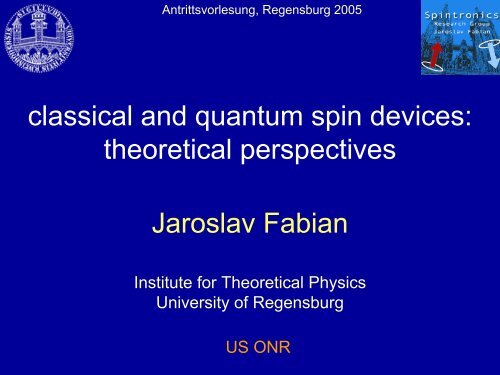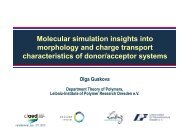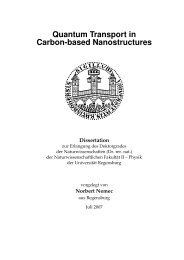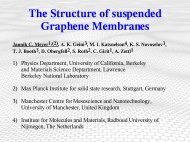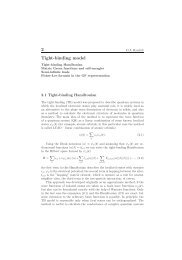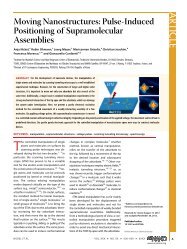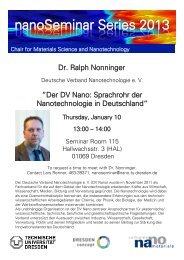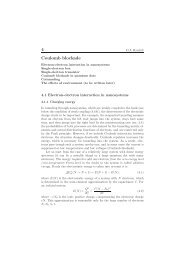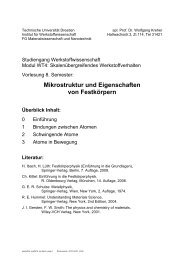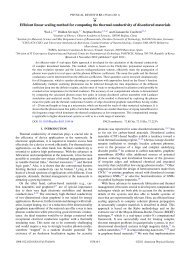slides (pdf)
slides (pdf)
slides (pdf)
Create successful ePaper yourself
Turn your PDF publications into a flip-book with our unique Google optimized e-Paper software.
Antrittsvorlesung, Regensburg 2005<br />
classical and quantum spin devices:<br />
theoretical perspectives<br />
Jaroslav Fabian<br />
Institute for Theoretical Physics<br />
University of Regensburg<br />
US ONR
:outline:<br />
• spintronics success story: metal-based devices<br />
• key concepts: spin injection and detection, spin relaxation<br />
• bipolar spintronics: selected novel phenomena<br />
• magnetic bipolar transistors<br />
• spin-to-charge conversion in coupled quantum dots<br />
• entanglement distillation by adiabatic passage (EDAP)<br />
• conclusions: challenges
Tunnel MagnetoResistance<br />
F I F<br />
Julliere 1975; Moodera et al. 1995<br />
small resistance large resistance<br />
TMR about 50-100%
sense current<br />
TMR non-volatile MRAM<br />
bit line (top)<br />
free layer, bit<br />
tunnel barrier AlO<br />
fixed (pinned) layer<br />
base electrode<br />
digit line (bottom)<br />
isolation transistor
TMR MRAM vs. CMOS NVRAM<br />
TMR MRAM NVRAM<br />
write / erase times 1 ns 10 μs / 1 ms<br />
write / erase energy 10 -10 J 10 -7 / 10 -5 J<br />
durability (cycles) > 10 15 10 5 –10 6<br />
Source: M. Johnson, J. Phys. Chem. B 109, 14278 (2005)
SPINTRONICS GOALS<br />
spin control of electrical properties<br />
(I-V characteristics)<br />
electrical control of spin<br />
(magnetization)
SPINTRONICS’ 3 REQUIREMENTS<br />
• EFFICIENT SPIN<br />
INJECTION<br />
• SLOW SPIN<br />
RELAXATION<br />
• RELIABLE SPIN<br />
DETECTION<br />
F N<br />
Silsbee-Johnson spin-charge coupling
BIPOLAR SPINTRONICS
atchet and paw vs. diode<br />
rectification of rotation vs. current
magnetic diode<br />
spin-voltaic effect
magnetic diode<br />
GMR
ipolar junction transistor<br />
• High speed digital circuits<br />
• BiCMOS<br />
microphone<br />
• Small signal amplification<br />
e<br />
emitter<br />
base<br />
collector<br />
• High frequency analog circuits (SiGe, GaAs HBTs)<br />
• Integrated Circuits market: 20% BJT, 75% MOSFET<br />
e<br />
e
Magnetic bipolar transistor (MBT)<br />
J. Fabian, I. Zutic and S. Das Sarma, cond-mat/0211639; Appl. Phys. Lett. 84, 85 (2004);<br />
J. Fabian and I. Zutic, Phys. Rev. B 69, 115314 (2004).<br />
j e<br />
forward<br />
N magnetic P<br />
N<br />
emitter<br />
V BE<br />
base<br />
w
drift-diffusion<br />
n-emitter p-m-base<br />
n-collector
charge and spin continuity
self-consistency with<br />
electrostatics
Analytical modeling<br />
Generalized Shockley theory:<br />
carrier and spin quasiequilibrium in<br />
space-charge regions (constant chemical potentials)<br />
+<br />
continuity of spin current through space-charge regions<br />
J. Fabian, I. Zutic, S. Das Sarma, Phys. Rev. B 66, 165301 (2002)
(giant) magnetoamplification<br />
n-emitter p-m-base n-collector<br />
Depletion<br />
layer<br />
Spin-charge coupling<br />
contribution to the<br />
emitter/base current<br />
n-emitter<br />
p-m-base
Numerical calculation
Bipolar spintronic devices<br />
• Spin-polarized p-n junction diode, spin capacitance<br />
I. Zutic, J. Fabian and S. Das Sarma, Phys. Rev. B 64, 121201 (2001)<br />
• Spin-polarized solar cell<br />
I. Zutic, J. Fabian and S. Das Sarma, Appl. Phys. Lett. 79, 1558 (2001)<br />
• Magnetic bipolar diode (MBD), GMR, spinvoltaic effect,<br />
spin injection, spin extraction<br />
I. Zutic, J. Fabian and S. Das Sarma, Phys. Rev. Lett. 88, 066603 (2002)<br />
• General theory of magnetic bipolar devices<br />
J. Fabian. I. Zutic, and S. Das Sarma, Phys. Rev. B 66, 165301 (2002)<br />
• Magnetic bipolar transistor (MBT)<br />
J. Fabian, I. Zutic, and S. Das Sarma, cond-mat/0211639; Appl. Phys. Lett. 84, 85 (2004)<br />
J. Fabian and I. Zutic, Phys. Rev. B 69, 115314 (2004); Appl. Phys. Lett. (2005)<br />
• Review<br />
I. Zutic, J. Fabian and S. Das Sarma, Rev. Mod. Phys. 76, 323 (2004)
experimental observation of<br />
spin-voltaic effect in p-n junctions<br />
H. Munekata, in Concepts in Spin Electronics, Ed. S. Maekawa, (January 2006)
RSFQ<br />
International Technology Roadmap<br />
for Semiconductors 2004:<br />
1-D<br />
structures<br />
Emerging Research Devices<br />
logic devices<br />
resonant<br />
tunneling SET molecular QCA<br />
risk<br />
spin<br />
transistor
:nanospintronics:<br />
spin-based quantum information processing<br />
D. Loss and D. P. DiVincenzo, PRA 57, 120 (1998)
spin-to-charge conversion<br />
spin-dependent tunneling<br />
P. Stano and J. Fabian, Phys. Rev. B 72, 155410 (2005)
STIRAP: stimulated Raman adiabatic passage
transfer through middle dot<br />
without<br />
transfer through middle dot
EDAP<br />
entanglement distillation by adiabatic passage
entanglement-selective transfer:<br />
triplets move, singlets stay<br />
J. Fabian and U. Hohenester, Phys. Rev. B (in press)
EDAP scheme:<br />
entanglement-to-charge conversion<br />
J. Fabian and U. Hohenester, Phys. Rev. B (in press)
Conclusions<br />
• new fundamental effects of spin-charge coupling<br />
• bipolar spintronics devices viable niche for magnetic<br />
semiconductors<br />
• spin quantum information processing in coupled dots:<br />
single and few spin manipulation, relaxation and<br />
decoherence, spin entanglement control<br />
• new designs for GaMnAs-based devices<br />
• silicon spintronics<br />
• spin and charge coherence in mesoscopic transport<br />
• multispin entanglement control<br />
Collaborators: I. Zutic (SUNY Buffalo), S. Das Sarma (UMD), J. Tse (UMD),<br />
P. Stano (U.R), U. Hohenester (U. Graz)


